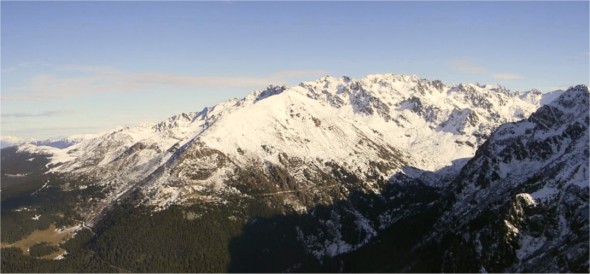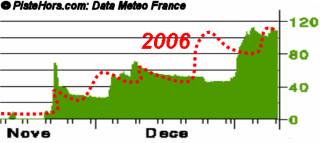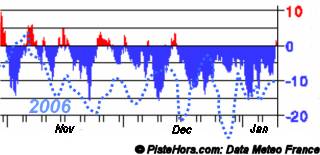Hi,
For some resaon the Center des Etudes des Neiges decided to password protect all that information. It is a pity as there was loads of useful data on the site.
If you are in a high altitude resort you may have noticed something strange covering the slopes this morning. A dusting of fresh snow at 1800 meters. Over the last few days there has been about 20cm of fresh but above the 2500 meters level but below 2000 meters the conditions have worsened from the already poor Christmas weak. The fault, record temperatures and rain.

In Chamonix the overnight minimum has hovered around 5°C with 3 days of light rain in the town. Normal January temperatures for France are around 5°C but since the start of the month the thermometer has recorded 12°C to 15°C with some peaks of 17°C; all this following what Meteo France has called the hottest autumn for 50 years. Some records have been broken, in the wine growing district of Corbiers in the south the temperature was more than 15°C and Toulouse’s Blagnac airport saw 17°C, breaking the previous record for a 9th January set in 1991. In Conqueyras in the Gard a scorching 21.7°C was recorded. Of course it has been hot before in January in 1982, another year with little snow, temperatures hit 19°C and in 1955 21°C.
Is global warming to blame? Yann Giezendanner forecaster for Météo France in Chamonix says that global warming, effectively more energy in the planet’s weather system means more extremese. Both of hot and cold. The exceptionally warm summer and autumn followed a harsh winter. The current mild weather is caused by a West to South-West air stream bringing warm air up from Morroco and looks set to continue for at least another 12 days. However nothing is certain says Giezendanner, the low pressure over Ireland only needs to move 1500km and there will be snow in the Alps. What is sure is that over the last century France has warmed faster than the world as a whole 1°C at sea level and 2°C in the mountains. Meteo France says that February will be colder but overall the winter of 2007 will be above average in temperature with a return to warm weather in March.

Snow cover at 3000 meters (la Plagne) is similar to 2006
The economic impacts are being felt. Due to well placed Christmas holiday most resorts, from the Pyrenees to the Alps, saw occupancy levels around 80%. Good for any year. The cold weather meant that snow canons could be run at resort level. Now it is not even possible to run snowmaking at night. The dry autumn also means that water is in short supply, in the Pyrenees it is the driest for 45 years in some areas. First victim is the Kandahar world cup race at les Houches. This was due to take place on the weekend of the 20th of January but has been moved to high altitude Val d’Isère where conditions are much better. Indeed the warmer 2007 could benefit high-altitude resorts which suffered in the cold of 2006. The Kandahar course was in a sorry state yesterday. A ribbon of soggy snow surrounded by fields. The run even had grass poking through. The resort had considered brining in snow by lorry and helicopter but had no guarantee this wouldn’t melt before the race.

...but it is much warmer
Season workers have also been hit hard. In the Northern and Hautes Alps the snowfall at the start of January meant that most waiting for a job have now been hired but elsewhere things are precarious with many now waiting for the February holidays to start work a full two months later than in a normal year. This means many will not have made sufficient social security payments to draw unemployment benefit during the interseason period.
The Pyrenees have also noted a drop in short stay bookings. January has benefited from low-cost airlines such as EasyJet and Ryanair bringing weekend skiers from Britain out to the mountains but this business has dried up like the winter snows. British skiers are uninterested in the alternative activities offered by the resorts such as mountain biking and hill walking. Ski instructors, guides and hire shops have been particularly hit by the drought of British visitors.
Looking off-piste in the Northern Alps it is still possible to find very soggy snow from 1200-1500 meters on shaded forest tracks with some skiable snow on south facing slopes at 1800 meters. The snowpack is isothermic (0C throughout) below 2000 meters with little overnight refreeze at this level. Rocks are not far from the surface below this altitude. The zero degree isotherm touched 3500 meters in the Northern Alps on Wednesday. There was around 15cm of new snow on the 4th above 2200 meters and a further 5-10cm on the 8th above 2500 meters. Skiing is on a refreeze or wind crust in many places, this softens during the day giving almost spring like snow conditions. There is little powder to be found except at altitude.
The rain has stabilized the snow-pack below 2500 meters with the main risk from wet snow slides as the slopes warm during the day. The Savoie still has some traps. A group set of a slab close to the pistes at Val d’Isère yesterday.
Hi,
For some resaon the Center des Etudes des Neiges decided to password protect all that information. It is a pity as there was loads of useful data on the site.